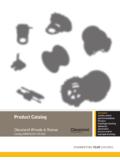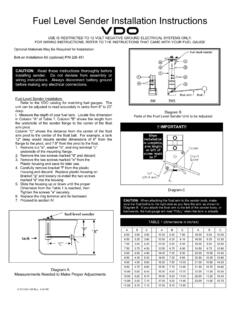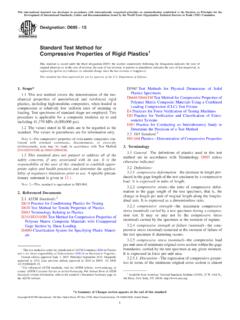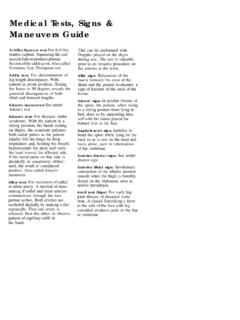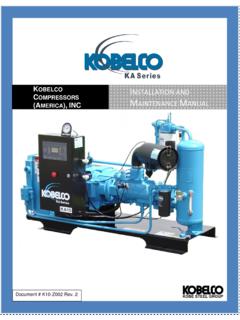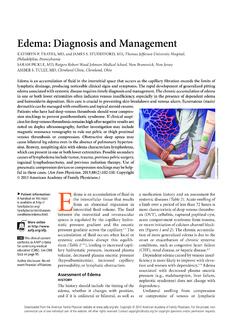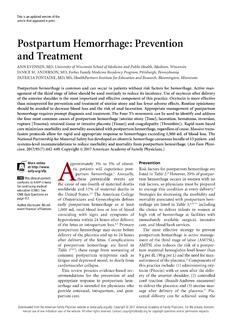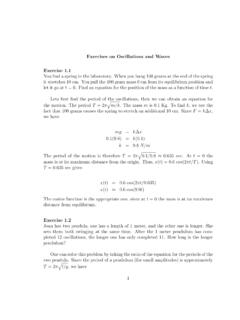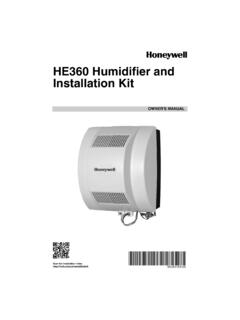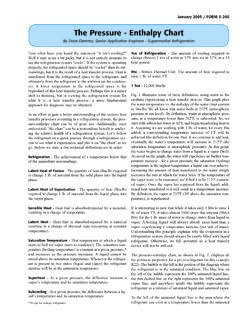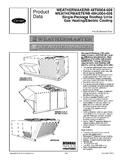Transcription of Aircraft Inspection, Repair & Alterations
1 INSPECTION, Repair &ALTERATIONSAIRCRAFTA cceptable Methods, Techniques & -1 BAC Department of TransportationFEDERAL AVIATION ADMINISTRATIONI ncludes:AC 1998 (Change 1, Sept. 27, 2001)AC 2008 AIRCRAF T INSPECTION, Repair & ALTERATIONSA ircraft Inspection, Repair & AlterationsAC , 1998AC , 2008 Aviation Supplies & Academics, 132nd Place SENewcastle, Washington 98059-3153 2013 Aviation Supplies & Academics, electronic publication is comprised of the same content as the Federal Aviation Administration s official release of this same title. ASA does not claim copyright on any material published herein that was taken from United States government sources. Hyperlinks and index tags have been incorporated throughout to facilitate ease of use for this electronic version.
2 All rights reserved. No part of this electronic file may be reproduced, transmitted, shared, distributed or resold without written permission from the 1-1 Page 1-1 CHAPTER 1. WOOD STRUCTURESECTION 1. MATERIALS AND PRACTICES1-1. GENERAL. Wood Aircraft construc-tion dates back to the early days of certificatedaircraft. Today only a limited number of woodaircraft structures are produced. However,many of the older airframes remain in proper care, airframes from the 1930 sthrough the 1950 s have held up remarkablywell considering the state of technology andlong term experience available at that time. Itis the responsibility of the mechanic to carefullyinspect such structures for deterioration andcontinuing Quality of Wood.
3 All wood and ply-wood used in the Repair of Aircraft structuresshould be of Aircraft quality (reference ArmyNavy Commerce Department BulletinANC-19, Wood Aircraft Inspection and Fabri-cation). Table 1-1 lists some permissiblevariations in characteristics and properties ofaircraft wood. However, selection and ap-proval of woodstock for Aircraft structural useare specialized skills and should be done bypersonnel who are thoroughly familiar with in-spection criteria and Substitution of Original Wood. Thewood species used to Repair a part should bethe same as that of the original whenever pos-sible; however, some permissible substitutesare given in table 1-1.
4 Obtain approval fromthe airframe manufacturer or the FederalAviation Administration (FAA) for the re-placement of modified woods or other non-wood products with a substitute Effects of Shrinkage. When themoisture content of a wooden part is lowered,the part shrinks. Since the shrinkage is notequal in all directions, the mechanic shouldconsider the effect that the Repair may have onthe completed structure. The shrinkage isgreatest in a tangential direction (across the fi-bers and parallel to the growth rings), some-what less in a radial direction (across the fibersand perpendicular to the growth rings), and isnegligible in a longitudinal direction (parallelto the fibers).
5 Figure 1-1 illustrates the differ-ent grain directions and the effects of shrink-age on the shape of a part. These dimensionalchanges can have several detrimental effectsupon a wood structure, such as loosening ofFIGURE 1-1. Relative shrinkage of wood members due to 1-2 Par 1-2 TABLE 1-1. Selection and Properties of Aircraft Wood. (See notes following table.)Species of WoodStrength proper-ties as comparedto spruceMaximumpermissiblegrain deviation (slope of grain) (Picea) Sitka ( ) Red (P. Rubra)White (P. Glauca).100%1:15 Excellent for all uses. Considered as standard forthis Fir(Pseudotsuga Taxifolia).Exceeds :15 May be used as substitute for spruce in same sizesor in slightly reduced sizes providing reductions aresubstantiated.
6 Difficult to work with tendency to split and splinter during fabrica-tion and considerable more care in manufacture isnecessary. Large solid pieces should be avoideddue to inspection difficulties. Gluing Fir(Abies Nobiles).Slightly exceedsspruce except8% deficient :15 Satisfactory characteristics with respect to work-ability, warping, and splitting. May be used as di-rect substitute for spruce in same sizes providingshear does not become critical. Hardness some-what less than spruce. Gluing Hemlock(Tsuga Heterpphylla).Slightly :15 Less uniform in texture than spruce. May be usedas direct substitute for spruce. Upland growth su-perior to lowland growth.
7 Gluing , Northern White (PinusStrobus).Properties be-tween 85 % and96 % those :15 Excellent working qualities and uniform in proper-ties, but somewhat low in hardness and shock-resisting capacity. Cannot be used as substitutefor spruce without increase in sizes to compensatefor lesser strength. Gluing Cedar, Port Orford(Charaecyparis Lawsoni-ana).Exceeds :15 May be used as substitute for spruce in same sizesor in slightly reduced sizes providing reductions aresubstantiated. Easy to work with handtools. Glu-ing difficult, but satisfactory joints can be obtainedif suitable precautions are , Yellow (LiriodendrowTulipifera).Slightly less thanspruce except incompression(crushing) :15 Excellent working qualities.
8 Should not be used asa direct substitute for spruce without carefully ac-counting for slightly reduced strength low in shock-resisting capacity. for Table 1-11. Defects Cross grain. Spiral grain, diagonal grain, or a combination of the two is acceptable providing the grain doesnot diverge from the longitudinal axis of the material more than specified in column 3. A check of all four faces of theboard is necessary to determine the amount of divergence. The direction of free-flowing ink will frequently assist indetermining grain Wavy, curly, and interlocked grain. Acceptable, if local irregularities do not exceed limitations specified forspiral and diagonal Hard knots. Sound, hard knots up to 3/8 inch in maximum diameter are acceptable providing: (1) they arenot projecting portions of I-beams, along the edges of rectangular or beveled unrouted beams, or along the edges offlanges of box beams (except in lowly stressed portions); (2) they do not cause grain divergence at the edges ofthe board or in the flanges of a beam more than specified in column 3; and (3) they are in the center third of thebeam and are not closer than 20 inches to another knot or other defect (pertains to 3/8 inch knots smaller knotsmay be proportionately closer).
9 Knots greater than 1/4 inch must be used with Pin knot clusters. Small clusters are acceptable providing they produce only a small effect on grain Pitch pockets. Acceptable in center portion of a beam providing they are at least 14 inches apart when theylie in the same growth ring and do not exceed 1-1/2 inches length by 1/8 inch width by 1/8 inch depth, and providingthey are not along the projecting portions of I-beams, along the edges of rectangular or beveled unrouted beams, oralong the edges of the flanges of box Mineral streaks. Acceptable, providing careful inspection fails to reveal any CHG 1 Par 1-2 Page 1-3 TABLE 1-1. Selection and Properties of Aircraft Wood. (See notes following table.) (continued)2.
10 Defects Not Cross grain. Not acceptable, unless within limitations noted in Wavy, curly, and interlocked grain. Not acceptable, unless within limitations noted in Hard knots. Not acceptable, unless within limitations noted in Pin knot clusters. Not acceptable, if they produce large effect on grain Spike knots. These are knots running completely through the depth of a beam perpendicular to the annualrings and appear most frequently in quarter-sawed lumber. Reject wood containing this Pitch pockets. Not acceptable, unless within limitations noted in Mineral streaks. Not acceptable, if accompanied by decay (see 1f).h. Checks, shakes, and splits. Checks are longitudinal cracks extending, in general, across the annual are longitudinal cracks usually between two annual rings.




